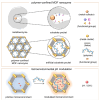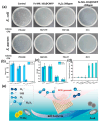Recent Advances in Metal-Organic Framework-Based Nanozymes for Intelligent Microbial Biosensing: A Comprehensive Review of Biomedical and Environmental Applications
- PMID: 40710087
- PMCID: PMC12293248
- DOI: 10.3390/bios15070437
Recent Advances in Metal-Organic Framework-Based Nanozymes for Intelligent Microbial Biosensing: A Comprehensive Review of Biomedical and Environmental Applications
Abstract
Metal-organic framework (MOF)-based nanozymes represent a groundbreaking frontier in advanced microbial biosensing, offering unparalleled catalytic precision and structural tunability to mimic natural enzymes with superior stability and specificity. By engineering the structural features and forming composites, MOFs are precisely tailored to amplify nanozymatic activity, enabling the highly sensitive, rapid, and cost-effective detection of a broad spectrum of microbial pathogens critical to biomedical diagnostics and environmental monitoring. These advanced biosensors surpass traditional enzyme systems in robustness and reusability, integrating seamlessly with smart diagnostic platforms for real-time, on-site microbial identification. This review highlights cutting-edge developments in MOF nanozyme design, composite engineering, and signal transduction integration while addressing pivotal challenges such as biocompatibility, complex matrix interference, and scalable manufacturing. Looking ahead, the convergence of multifunctional MOF nanozymes with portable technologies and optimized in vivo performance will drive transformative breakthroughs in early disease detection, antimicrobial resistance surveillance, and environmental pathogen control, establishing a new paradigm in next-generation smart biosensing.
Keywords: biomedical; environmental; enzyme mimetics; metal–organic framework-based nanozymes; microbial biosensing; point-of-care diagnostics.
Conflict of interest statement
The authors declare no conflicts of interest.
Figures













Similar articles
-
The fusion of metal-organic framework (MOF) and covalent organic framework (COF): A synergistic leap toward bridging boundaries in catalytic, sensing, and biomedical frontiers.Adv Colloid Interface Sci. 2025 Jul 22;344:103613. doi: 10.1016/j.cis.2025.103613. Online ahead of print. Adv Colloid Interface Sci. 2025. PMID: 40714298 Review.
-
Recent Advancements in Metal-Organic Framework-Based Microfluidic Chips for Biomedical Applications.Micromachines (Basel). 2025 Jun 24;16(7):736. doi: 10.3390/mi16070736. Micromachines (Basel). 2025. PMID: 40731645 Free PMC article. Review.
-
Artificial intelligence-driven revolution in nanozyme design: from serendipity to rational engineering.Mater Horiz. 2025 Jun 26. doi: 10.1039/d5mh00719d. Online ahead of print. Mater Horiz. 2025. PMID: 40569573 Review.
-
MOF-on-MOF nanomaterial (Fe-MOF@UiO-66)-based ratiometric fluorescence/colorimetric dual-mode sensor for ultrasensitive detection of uric acid.Anal Chim Acta. 2025 Sep 22;1368:344325. doi: 10.1016/j.aca.2025.344325. Epub 2025 Jun 11. Anal Chim Acta. 2025. PMID: 40670001
-
2D nanozymes: bioinspired innovations for healthcare and environmental applications.Chem Commun (Camb). 2025 Jul 15;61(58):10685-10715. doi: 10.1039/d5cc00180c. Chem Commun (Camb). 2025. PMID: 40556431 Review.
References
-
- Oluwaseun O., Singleton I., Sant A.S., January S. Since January 2020 Elsevier has created a COVID-19 resource centre with free information in English and Mandarin on the novel coronavirus COVID-19. The COVID-19 resource centre is hosted on Elsevier Connect, the company’s public news and information. Food Microbiol. 2020;73:177–208.
-
- Edmiston C.E., Seabrook G.R., Cambria R.A., Brown K.R., Lewis B.D., Sommers J.R., Krepel C.J., Wilson P.J., Sinski S., Towne J.B. Molecular epidemiology of microbial contamination in the operating room environment: Is there a risk for infection? Surgery. 2005;138:573–582. doi: 10.1016/j.surg.2005.06.045. - DOI - PubMed
Publication types
MeSH terms
Substances
Grants and funding
LinkOut - more resources
Full Text Sources

